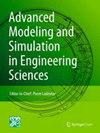Asymptotically consistent and computationally efficient modeling of short-ranged molecular interactions between curved slender fibers undergoing large 3D deformations
IF 3.2
Q3 MECHANICS
Advanced Modeling and Simulation in Engineering Sciences
Pub Date : 2024-04-15
DOI:10.1186/s40323-023-00257-9
引用次数: 0
Abstract
This article proposes a novel computational modeling approach for short-ranged molecular interactions between curved slender fibers undergoing large 3D deformations, and gives a detailed overview how it fits into the framework of existing fiber or beam interaction models, either considering microscale molecular or macroscale contact effects. The direct evaluation of a molecular interaction potential between two general bodies in 3D space would require to integrate molecule densities over two 3D volumes, leading to a sixfold integral to be solved numerically. By exploiting the short-range nature of the considered class of interaction potentials as well as the fundamental kinematic assumption of undeformable fiber cross-sections, as typically applied in mechanical beam theories, a recently derived, closed-form analytical solution is applied for the interaction potential between a given section of the first fiber (slave beam) and the entire second fiber (master beam), whose geometry is linearly expanded at the point with smallest distance to the given slave beam section. This novel approach based on a pre-defined section–beam interaction potential (SBIP) requires only one single integration step along the slave beam length to be performed numerically. In addition to significant gains in computational efficiency, the total beam–beam interaction potential resulting from this approach is shown to exhibit an asymptotically consistent angular and distance scaling behavior. Critically for the numerical solution scheme, a regularization of the interaction potential in the zero-separation limit as well as the finite element discretization of the interacting fibers, modeled by the geometrically exact beam theory, are presented. In addition to elementary two-fiber systems, carefully chosen to verify accuracy and asymptotic consistence of the proposed SBIP approach, a potential practical application in form of adhesive nanofiber-grafted surfaces is studied. Involving a large number of helicoidal fibers undergoing large 3D deformations, arbitrary mutual fiber orientations as well as frequent local fiber pull-off and snap-into-contact events, this example demonstrates the robustness and computational efficiency of the new approach.对发生三维大变形的弯曲细长纤维之间的短程分子相互作用进行渐近一致且计算高效的建模
本文提出了一种新颖的计算建模方法,适用于发生较大三维变形的弯曲细长纤维之间的短程分子相互作用,并详细概述了该方法如何融入现有的纤维或梁相互作用模型框架,无论是考虑微观尺度的分子效应还是宏观尺度的接触效应。要直接评估三维空间中两个一般物体之间的分子相互作用势,需要对两个三维空间中的分子密度进行积分,从而产生一个需要数值求解的六倍积分。通过利用所考虑的这一类相互作用势的短程性质,以及通常应用于机械梁理论的纤维横截面不可变形的基本运动学假设,对第一根纤维的给定截面(从梁)和整个第二根纤维(主梁)之间的相互作用势应用了最近推导出的闭式解析解。这种基于预定义的截面-光束相互作用势(SBIP)的新方法只需沿着从光束长度进行一次数值积分。除了显著提高计算效率外,这种方法产生的总梁-梁相互作用势还表现出渐近一致的角度和距离缩放行为。对于数值求解方案至关重要的是,介绍了零分离极限下相互作用势的正则化,以及以几何精确梁理论为模型的相互作用纤维的有限元离散化。除了为验证 SBIP 方法的准确性和渐近一致性而精心选择的基本双纤维系统外,还研究了纳米纤维粘接表面的潜在实际应用。该实例涉及大量螺旋形纤维,这些纤维经历了较大的三维变形、任意的相互纤维方向以及频繁的局部纤维拉断和卡入接触事件,证明了新方法的稳健性和计算效率。
本文章由计算机程序翻译,如有差异,请以英文原文为准。
求助全文
约1分钟内获得全文
求助全文
来源期刊

Advanced Modeling and Simulation in Engineering Sciences
Engineering-Engineering (miscellaneous)
CiteScore
6.80
自引率
0.00%
发文量
22
审稿时长
30 weeks
期刊介绍:
The research topics addressed by Advanced Modeling and Simulation in Engineering Sciences (AMSES) cover the vast domain of the advanced modeling and simulation of materials, processes and structures governed by the laws of mechanics. The emphasis is on advanced and innovative modeling approaches and numerical strategies. The main objective is to describe the actual physics of large mechanical systems with complicated geometries as accurately as possible using complex, highly nonlinear and coupled multiphysics and multiscale models, and then to carry out simulations with these complex models as rapidly as possible. In other words, this research revolves around efficient numerical modeling along with model verification and validation. Therefore, the corresponding papers deal with advanced modeling and simulation, efficient optimization, inverse analysis, data-driven computation and simulation-based control. These challenging issues require multidisciplinary efforts – particularly in modeling, numerical analysis and computer science – which are treated in this journal.
 求助内容:
求助内容: 应助结果提醒方式:
应助结果提醒方式:


